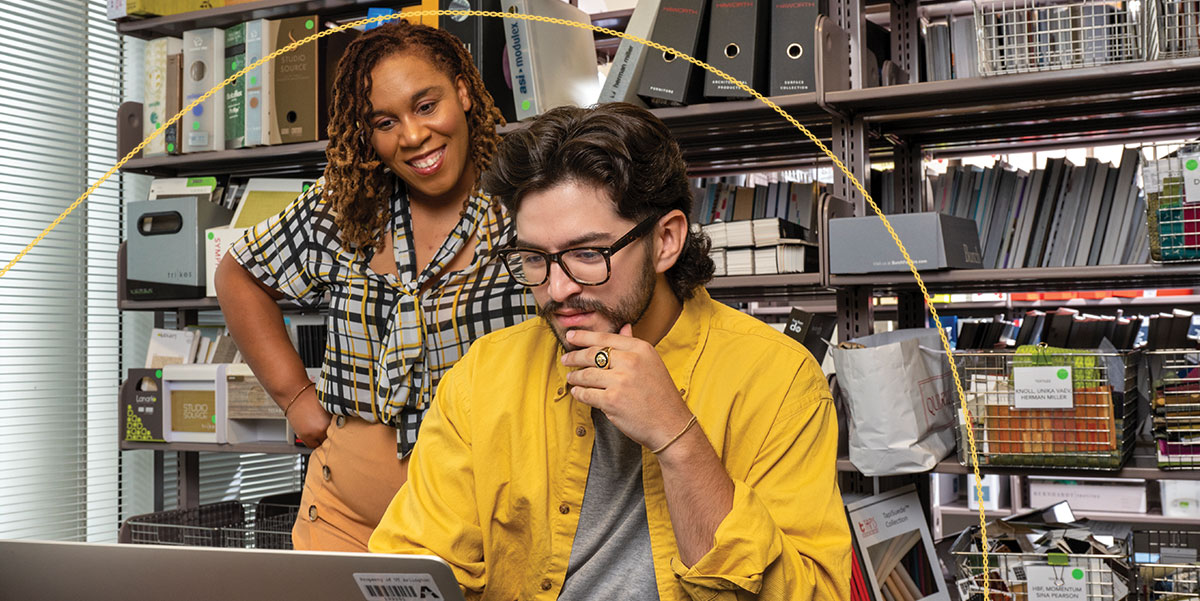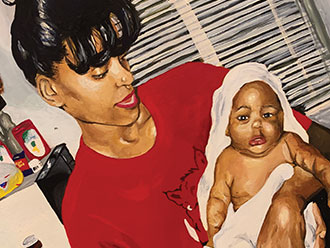Currently professional opera singers in New York City, Raehann Bryce-Davis (left) and Tesia Kwarteng first met at UTA.
When Raehann Bryce-Davis saw Tesia Kwarteng walking into the Fine Arts Building, she was relieved to know she wouldn’t be alone. In each other, the two Black female opera singers would find not only companionship, but also shared dreams and the same strong work ethic. That first meeting marked more than a decade of friendship that saw them cheering each other on across states and oceans as they pursued their careers as professional opera singers on some of the world’s most prominent stages.
Connections like these are forged every day at UTA, where students form enduring relationships and engage in mentorships and professional networking. Connections like these are built to last, as our students graduate into a community of over 250,000 alumni. Their journeys are diverse, but they are always bonded by the shared experience of learning and growing in Maverick Country.
A Dynamic Duo
“I was on my own when it came to figuring out what this career looks like after graduation,” says Bryce-Davis, who graduated in 2010 with Bachelor of Music in vocal performance. “I did the research, found the programs and resources available, and excitedly shared what I’d learned when I found somebody with the same goals. I shared with several people, but not everyone listened. Tesia, though, was really intentional about the career she wanted to have.”
Kwarteng, who graduated with her Bachelor of Music in vocal performance a year after Bryce-Davis, says she was happy to absorb her friend’s knowledge.
“I knew I wanted to perform, and I knew I wanted to be in New York, but I had no idea what that actually looked like,” she says. “Raehann put in the work to make that happen.”
When Bryce-Davis finished her degree at UTA, she enrolled in graduate studies at the Manhattan School of Music (MSM) in New York and invited Kwarteng to visit and tour the school. The visit resulted in Kwarteng making the move to New York after her own graduation, and the two friends found themselves as students together again at MSM. There, Kwarteng says, Bryce-Davis continued to show her the ropes and help her find her way.
After graduating from MSM, Kwarteng and Bryce-Davis followed different paths to stages around the world, but they have followed each other’s accomplishments along the way. Their shared perspective as Black women in opera gave them a deeper appreciation for what they each have faced on their way to acclaim.
“We’ve all had the experience of being the only or one of a few Black performers on a project,” Kwarteng says. “There is a sense of relief when you know that somebody else in the room knows your experience and is there to support you and keep you uplifted within a field that can make you feel as if you don’t belong.”
“When you feel like no one understands, you can feel very, very alone, and that’s a difficult thing,” Bryce-Davis adds. “That’s one of the reasons representation is so important; we need to feel a connection to be able to feel whole.”
Bryce-Davis and Kwarteng made separate debuts at New York City’s prestigious Metropolitan Opera in early 2022. As they watched each other shine, they joyfully reflected on how far they have come since first meeting in front of UTA’s Fine Arts Building.
“It’s really exciting to see how this has unfolded, and it hasn’t been without sacrifice or struggle,” Kwarteng says. “To know the work someone has put in and the steps they’ve taken to get to these moments— it’s just great. We’re out here doing this thing.”
When reflecting on the impact of having a fellow Black female opera singer on her team from an early stage, Kwarteng called it “indescribable.”
“For Raehann to be so open and gracious with information she got along the way and pass it down, that’s the kind of thing we need,” Kwarteng says. “Now I can reach back and help the generation coming up behind us.”
“I needed help across the board, especially when it came to setting up resumes and portfolios, entering an interview, and engaging with architecture firms and their higher-ups.”

Through the MavMentors program, interior designer Veronica Sanders helped architecture student Gerardo Alvarez advance his professional skills.
Expanding Perspectives
Gerardo Alvarez (’22 BS, Architecture) arrived at UTA fresh from his decision to pivot from studying aerospace engineering to architecture. Though he was excited to tackle the discipline, he felt like he was behind as he listened to fellow students talk about programs they were doing and how they had been studying architecture since high school.
As a first-generation student, Alvarez received support from his family, but they didn’t know how to help him—so when he came across UTA’s MavMentors program in a campus email, he saw it as an opportunity to start garnering the knowledge he would need to succeed in the real world.
MavMentors fosters meaningful partnerships between alumni and student mentees that will help mentees better navigate their career path. In the program, mentees are encouraged to choose a mentor who best matches their current and future professional goals, but Alvarez saw it as a chance to connect with someone who could broaden his understanding of the field.
“It was a purposeful, strategic move to pick a mentor who was outside of my discipline,” Alvarez says. “I didn’t really just want to hear more about architecture; I wanted to have an opportunity to hear from other portions of the field, like interior design.”
The mentor who MavMentors connected him with was Veronica Sanders (’18 BS, Interior Design), CEO and principal interior designer at Design with Veronica Sanders LLC. Sanders laughs as she reflects on how, despite their different professional focuses, her journey mirrors Alvarez’s.
“One of the reasons I wanted to join MavMentors as a mentor is because I’m also a first-generation graduate,” she says. “I know what it was like to not have mentorship or someone to guide me through the admissions process, classes, or filling out scholarship forms. I knew that somewhere out there was another first-generation student who’s struggling, and I can offer them support.”
Sanders and Alvarez agree that interior design and architecture are closely aligned but not often intersecting in ways that could maximize the benefits of collaboration.
“With Gerardo, I could give him the interior designer’s perspective on architecture and share how we lean on architects and how we hope architects will lean on us,” she says.
Given their intentionality about expanding their professional perspectives, it is no surprise that Sanders and Alvarez hit it off within just a few minutes of meeting. Alvarez said Sanders’ friendly and open nature helped the relationship feel organic from the start, while Sanders attributes the success of their mentor-mentee relationship to Alvarez’s inherent curiosity and preparedness.
“I needed help across the board, especially when it came to setting up resumes and portfolios, entering an interview, and engaging with architecture firms and their higher-ups,” Alvarez says. “As I got closer to graduation, questions flooded in, and I’d jot them down to ask Veronica about.
“What I really appreciate about Veronica is how she calmed that panic by reminding me that I’m capable,” Alvarez adds. “It’s easy to get caught up in the business of architecture, but she reminded me I’m still an artist and that I should keep my mind open and be creative to avoid falling in a groove of this just being a job.”
After graduating, Alvarez went to work at Von Perry LLC, a startup that develops 3D-printed houses with the goal of developing affordable housing.
Inspired by her experience mentoring Alvarez, Sanders decided to embark on a new career journey as an adjunct professor at Dallas College’s El Centro Campus. She said meeting Alvarez through MavMentors sparked a love of teaching and a desire to continue mentoring students.
At the start, Sanders and Alvarez thought their time would be focused on a former student passing knowledge to a current student. Instead, they landed in a mutually inspiring relationship filled with shared admiration.
As Sanders notes, “As professionals, we can do so much better if we work together.”
“It goes beyond friendship. This togetherness, this sisterhood, and the memories that come with it have gotten me through a whole lot.”

Margaret Monostory Crowley and Lolin Martins-Crane have been best friends since they met on the UTA campus at just 4 years old. They are both UTA alumni and current University employees.
Growing Through Life
Maverick friendships are long-lasting, but Lolín Martins-Crane (’88 BA, Psychology) and Margaret Monostory Crowley (’88 BFA, Theatrical Production) likely have them all beat. The pair met on the UTA campus when they were just 4 years old, both attending a party for Martins-Crane’s father, who was a new professor in what was then known as the Department of Foreign Languages. Monostory’s father was a professor in the department as well.
While the girls were each excited to see someone their own age at this grown-up party, their first evening of playing together unfortunately ended with a bit of thievery.
“I had this stuffed elephant my grandmother had made specially for me,” Monostory recalls. “Lolín and I played with it at this party, then, all of a sudden, I didn’t have my elephant. I wandered the party looking for it, only to find Lolín curled in her mother’s lap with it tucked under her arm.”
Monostory fought the urge to wake the sleeping Martins-Crane, and her grandmother made Martins-Crane her very own stuffed elephant so she would not have to steal Monostory’s anymore.
With that, their budding friendship was back on track. Good thing, too, because they would spend the nearly two decades that followed together, going to all the same schools and ultimately deciding to attend UTA after high school.
At UTA, their paths started to deviate from one another as Martins-Crane studied psychology and Monostory pursued theatre arts. Their first real separation came when they elected to go to different graduate schools before putting down roots in different cities.
In spite of the distance, Martins-Crane and Monostory continued to see each other through life’s biggest milestones. When Martins-Crane had children, Monostory made them their own stuffed elephants.
Martins-Crane and Monostory are both only children, and their families, because they were small, shared every holiday and big event growing up. For Martins-Crane, this is why it was imperative they stayed a part of each other’s lives through the years apart.
“Now that our parents are deceased, this is the only person I share these memories with,” Martins-Crane says as Monostory nods. “It goes beyond friendship. This togetherness, this sisterhood, and the memories that come with it have gotten me through a whole lot.”
In 2016, Martins-Crane returned to UTA as director of the Career Development Center and describes the opportunity like it was “coming home.” In 2018, she happened to run into the chair of the Theatre Arts Department. Seizing the opportunity to bring her friend home, Martins-Crane asked the chair if there were any openings on the faculty and pitched Monostory, who was working as an adjunct professor at the University of Houston.
Martins-Crane’s boldness paid off, and Monostory returned to UTA in spring 2018 as an assistant professor of theatre arts. “I had been trying to get back to UTA for a long time because of the impact it had on me,” she says.
At long last, these lifelong friends are living in the same city again and have picked up right where they left off.
“I just think our dads would both be so proud of us,” Martins-Crane says, beaming. “I think they’re looking down saying, ‘That’s it. That’s where you’re supposed to be.’” UTA


